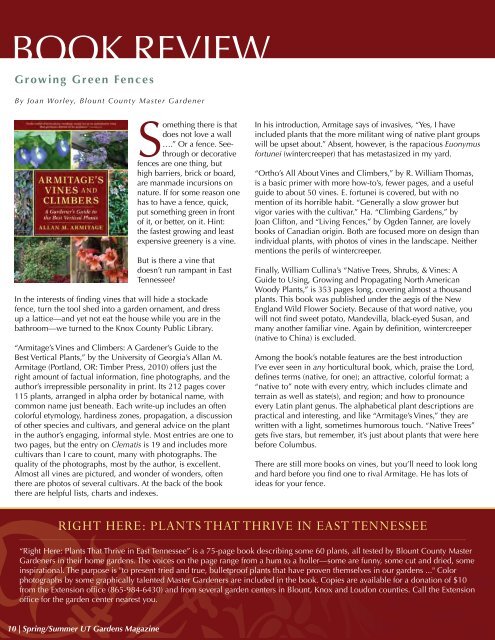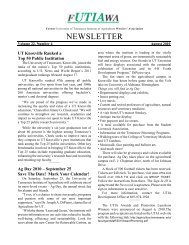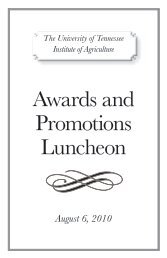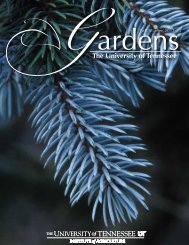Spring/Summer 2012 - The University of Tennessee
Spring/Summer 2012 - The University of Tennessee
Spring/Summer 2012 - The University of Tennessee
You also want an ePaper? Increase the reach of your titles
YUMPU automatically turns print PDFs into web optimized ePapers that Google loves.
Growing Green Fences<br />
By Joan Worley, Blount County Master Gardener<br />
Something there is that<br />
does not love a wall<br />
….” Or a fence. Seethrough<br />
or decorative<br />
fences are one thing, but<br />
high barriers, brick or board,<br />
are manmade incursions on<br />
nature. If for some reason one<br />
has to have a fence, quick,<br />
put something green in front<br />
<strong>of</strong> it, or better, on it. Hint:<br />
the fastest growing and least<br />
expensive greenery is a vine.<br />
But is there a vine that<br />
doesn’t run rampant in East<br />
<strong>Tennessee</strong>?<br />
In the interests <strong>of</strong> finding vines that will hide a stockade<br />
fence, turn the tool shed into a garden ornament, and dress<br />
up a lattice—and yet not eat the house while you are in the<br />
bathroom—we turned to the Knox County Public Library.<br />
“Armitage’s Vines and Climbers: A Gardener’s Guide to the<br />
Best Vertical Plants,” by the <strong>University</strong> <strong>of</strong> Georgia’s Allan M.<br />
Armitage (Portland, OR: Timber Press, 2010) <strong>of</strong>fers just the<br />
right amount <strong>of</strong> factual information, fine photographs, and the<br />
author’s irrepressible personality in print. Its 212 pages cover<br />
115 plants, arranged in alpha order by botanical name, with<br />
common name just beneath. Each write-up includes an <strong>of</strong>ten<br />
colorful etymology, hardiness zones, propagation, a discussion<br />
<strong>of</strong> other species and cultivars, and general advice on the plant<br />
in the author’s engaging, informal style. Most entries are one to<br />
two pages, but the entry on Clematis is 19 and includes more<br />
cultivars than I care to count, many with photographs. <strong>The</strong><br />
quality <strong>of</strong> the photographs, most by the author, is excellent.<br />
Almost all vines are pictured, and wonder <strong>of</strong> wonders, <strong>of</strong>ten<br />
there are photos <strong>of</strong> several cultivars. At the back <strong>of</strong> the book<br />
there are helpful lists, charts and indexes.<br />
In his introduction, Armitage says <strong>of</strong> invasives, “Yes, I have<br />
included plants that the more militant wing <strong>of</strong> native plant groups<br />
will be upset about.” Absent, however, is the rapacious Euonymus<br />
fortunei (wintercreeper) that has metastasized in my yard.<br />
“Ortho’s All About Vines and Climbers,” by R. William Thomas,<br />
is a basic primer with more how-to’s, fewer pages, and a useful<br />
guide to about 50 vines. E. fortunei is covered, but with no<br />
mention <strong>of</strong> its horrible habit. “Generally a slow grower but<br />
vigor varies with the cultivar.” Ha. “Climbing Gardens,” by<br />
Joan Clifton, and “Living Fences,” by Ogden Tanner, are lovely<br />
books <strong>of</strong> Canadian origin. Both are focused more on design than<br />
individual plants, with photos <strong>of</strong> vines in the landscape. Neither<br />
mentions the perils <strong>of</strong> wintercreeper.<br />
Finally, William Cullina’s “Native Trees, Shrubs, & Vines: A<br />
Guide to Using, Growing and Propagating North American<br />
Woody Plants,” is 353 pages long, covering almost a thousand<br />
plants. This book was published under the aegis <strong>of</strong> the New<br />
England Wild Flower Society. Because <strong>of</strong> that word native, you<br />
will not find sweet potato, Mandevilla, black-eyed Susan, and<br />
many another familiar vine. Again by definition, wintercreeper<br />
(native to China) is excluded.<br />
Among the book’s notable features are the best introduction<br />
I’ve ever seen in any horticultural book, which, praise the Lord,<br />
defines terms (native, for one); an attractive, colorful format; a<br />
“native to” note with every entry, which includes climate and<br />
terrain as well as state(s), and region; and how to pronounce<br />
every Latin plant genus. <strong>The</strong> alphabetical plant descriptions are<br />
practical and interesting, and like “Armitage’s Vines,” they are<br />
written with a light, sometimes humorous touch. “Native Trees”<br />
gets five stars, but remember, it’s just about plants that were here<br />
before Columbus.<br />
<strong>The</strong>re are still more books on vines, but you’ll need to look long<br />
and hard before you find one to rival Armitage. He has lots <strong>of</strong><br />
ideas for your fence.<br />
Right Here: Plants That Thrive in East <strong>Tennessee</strong><br />
“Right Here: Plants That Thrive in East <strong>Tennessee</strong>” is a 75-page book describing some 60 plants, all tested by Blount County Master<br />
Gardeners in their home gardens. <strong>The</strong> voices on the page range from a hum to a holler—some are funny, some cut and dried, some<br />
inspirational. <strong>The</strong> purpose is "to present tried and true, bulletpro<strong>of</strong> plants that have proven themselves in our gardens ..." Color<br />
photographs by some graphically talented Master Gardeners are included in the book. Copies are available for a donation <strong>of</strong> $10<br />
from the Extension <strong>of</strong>fice (865-984-6430) and from several garden centers in Blount, Knox and Loudon counties. Call the Extension<br />
<strong>of</strong>fice for the garden center nearest you.<br />
10 | <strong>Spring</strong>/<strong>Summer</strong> UT Gardens Magazine

















